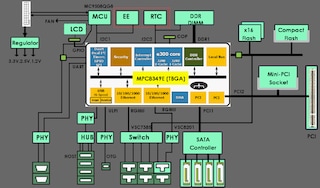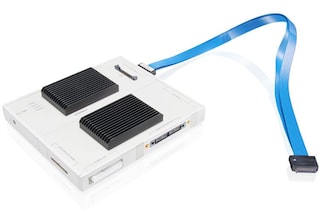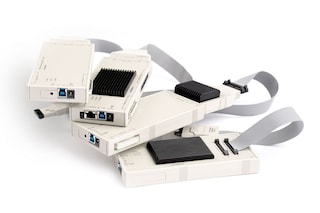
PowerQUICC® II Pro Processor with DDR2, PCI, 1 GB Ethernet, Dual USB, Security
The MPC8343E PowerQUICC® II™ Pro integrated communications processor is a next-generation extension of the popular PowerQUICC II line. Based on a system-on-chip (SoC) architecture, the MPC8343E PowerQUICC II Pro integrates the enhanced e300 core and advanced features, such as DDR memory, Dual Gigabit Ethernet, Dual PCI and Hi-Speed USB controllers. With clock speeds scaling to 400 MHz, the MPC8343E processor offers the highest performing PowerQUICC II devices available.
The MPC8343E PowerQUICC II Pro is designed to provide a cost-effective, highly integrated control processing solution that addresses the emerging needs of networking, communications and pervasive computing applications. MPC8343E processor can be used in applications such as Ethernet routers and switches, wireless LAN (WLAN) equipment, network storage, home network appliances, industrial control equipment, and copiers, printers and other imaging systems.
e300 SoC Platform
The MPC8343E PowerQUICC II Pro is based on the e300 SoC platform—making it easy and fast to add or remove functional blocks and develop additional SoC-based family members targeting emerging market requirements. At the heart of the e300 SoC platform is NXP® Semiconductors's e300 core built on Power Architecture technology. The e300 core is an enhanced version of the 603e Power Architecture core used in previous-generation PowerQUICC II processors. Enhancements include twice as much L1 cache (32 KB data cache and 32 KB instruction cache) with integrated parity checking, and other performance-enhancing features. The e300 core is completely software-compatible with existing 603e core-based products.
Integrated Security
The MPC8343E features a powerful integrated security engine derived from NXP Semiconductors's security coprocessor product line. The MPC8343E security engine supports DES, 3DES, MD-5, SHA-1, AES, and ARC-4 encryption algorithms, as well as a public key accelerator and an on-chip random number generator. The security engine is capable of single-pass encryption and authentication, as required by IPsec, IEEE® 802.11i standard and other security protocols.

Are you working with NXP processors or microcontrollers?
Don’t spend your money solving issues that NXP has already solved.
With NXP’s Premium Support, you’re getting expert help and a contractually obligated agreement for high-quality technical assistance. Enjoy guaranteed response times and direct access to NXP engineers who have likely already solved the issues you are facing.
Benefits include:Click here to discover how Premium Support can optimize your next design.
|
|
|
|
|
|
|
|---|---|---|---|---|---|
|
|
|
|
|
|
|
|
|
|
|
|
|
|
|
|
|
|
|
|
|
|
|
|
|
|
|
|
|
|
|
|
|
|
|
|
|
|
|
|
|
|
|
|
|
|
|
|
|
|
|
|
|
|
|
|
|
|
|
|
|
|
|
|
|
|
|
|
|
|
Quick reference to our documentation types
1-10 of 48 documents
Compact List
Please wait while your secure files are loading.
Receive the full breakdown. See the product footprint and more in the eCad file.

Receive the full breakdown. See the product footprint and more in the eCad file.
3 hardware offerings



3 hardware offerings



To find additional partner offerings that support this product, visit our Partner Marketplace.
Quick reference to our software types.
3 software files
Note: For better experience, software downloads are recommended on desktop.
Please wait while your secure files are loading.
1-5 of 18 software offerings


















To find additional partner offerings that support this product, visit our Partner Marketplace.
1-5 of 11 engineering services











There are no results for this selection.
To find additional partner offerings that support this product, visit our Partner Marketplace.
8 trainings
To find additional partner offerings that support this product, visit our Partner Marketplace.